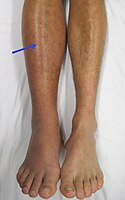
Photo from wikipedia
Background There have been well-documented implications of race/ethnicity on the outcome of various vascular diseases, yet there are limited data on risk factors and outcome of lower limb swelling. While… Click to show full abstract
Background There have been well-documented implications of race/ethnicity on the outcome of various vascular diseases, yet there are limited data on risk factors and outcome of lower limb swelling. While many patients improve with endovenous therapy (thermal ablation or iliac vein stenting), some patients’ symptoms persist. The goal of this study was to identify clinical factors including race/ethnicity related to persistent leg swelling after treatment with both iliac vein stenting and thermal ablation. Methods From February 2012 to February 2014, this observational study analyzed data for 173 patients with chronic venous insufficiency who underwent both iliac vein stent placement as well as thermal ablation (radiofrequency ablation or endovenous laser ablation). All procedures of the thermal ablations and the iliac vein stenting were staged. Iliac vein stenosis was identified using intravascular ultrasound of the iliofemoral venous segment showing >50% cross-sectional area or diameter reduction. The patients were queried to the resolution of their leg swelling after both procedures were performed. The resolution of swelling was correlated with age, gender, presenting sign according to CEAP classification, race/ethnicity and degree of iliac vein stenosis. Patients were categorized by Caucasians (n = 97), African Americans (n = 27), or Hispanics (n = 49). Statistical analysis performed using Chi-square and Student’s t test. Results Of the total 173 patients who underwent both endovenous closure and iliac vein stent placements, 117 (67.6%) patients were women. The average age was 67 (±13 SD) years. The average pain score was 2.9(±3.1 SD). The average degree of iliac vein stenosis was 66.5(±13.3 SD). About 56.1% were Caucasians, 15.6% were African Americans, and 28.3% were Hispanics. The number of patients with iliac vein stent thrombosis was 2. One hundred fifty-two (87.9%) patients stated that they had improvement in swelling after combined procedures, 100 (65.8%) patients were women. The average age was 67.3 (±13 SD) years. The average pain score was 2.9 (±3.1 SD). The average degree of iliac vein stenosis was 67.3% (±12.8 SD). About 56.6% were Caucasians, 15.1% were African Americans, and 28.3% were Hispanics. The number of patients with iliac vein stent thrombosis was 1. Twenty-one (12.1%) patients stated they had no improvement after both procedures. Correlating these group factors with the group of patients who improved their swelling after the combined procedures we found the following: 17 (81%) of these patients were females (P=0.16). The average age was 68.4 (±17 SD) years (P=0.72 SD). The average pain score was 3.2 (±3.7 SD) (P=0.68). The average degree of iliac vein stenosis was 60.2% (±15.9 SD) (P=0.02). Around 52.4% were Caucasians, 19% were African Americans, and 28.6% were Hispanics (P=0.88). The number of patients with iliac vein stent thrombosis was 1 (P = 0.1). Conclusion These data suggest that the clinical factors including race are not clinically significant factors in the response to swelling after combined iliac stent and endovenous ablation procedures. Interestingly, a higher degree of iliac vein stenosis was associated with improved resolution of swelling
Journal Title: Vascular
Year Published: 2018
Link to full text (if available)
Share on Social Media: Sign Up to like & get
recommendations!